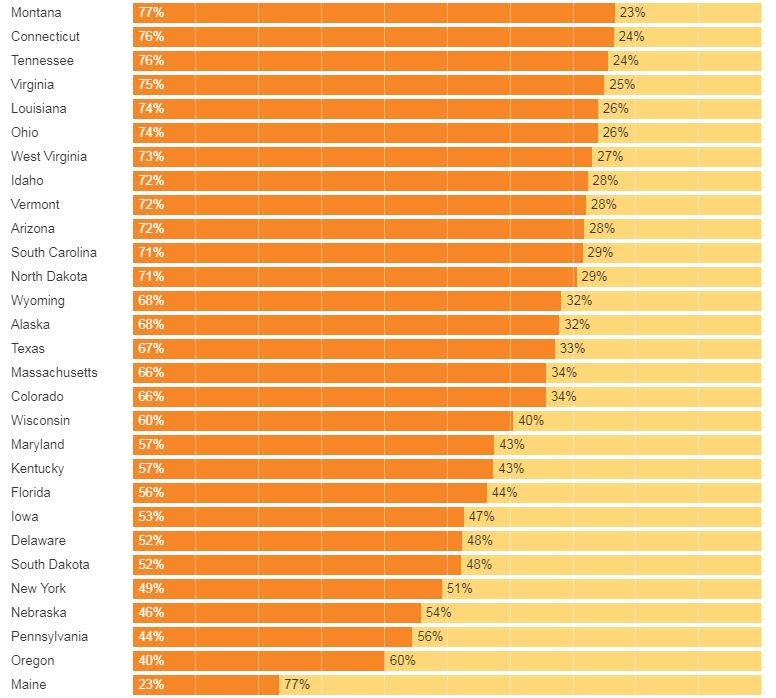Medicaid Enrollment and Unwinding Tracker
By KFF / January 9, 2024
The Medicaid Enrollment and Unwinding Tracker presents the most recent data on monthly Medicaid disenrollments, renewals, overall enrollment and other key indicators reported by states during the unwinding of the Medicaid continuous enrollment provision. The unwinding data are pulled from state websites, where available, and from the Centers for Medicare & Medicaid Services (CMS).
Medicaid Disenrollments
At least 14,377,000 Medicaid enrollees have been disenrolled as of January 9, 2024, based on the most current data from all 50 states and the District of Columbia. Overall, 34% of people with a completed renewal were disenrolled in reporting states while 66%, or 26.9 million enrollees, had their coverage renewed (one reporting state does not include data on renewed enrollees). Due to varying lags for when states report data, the data reported here undercount the actual number of disenrollments to date.
There is wide variation in disenrollment rates across reporting states, ranging from 62% in Texas to 10% in Maine. Differences in who states are targeting with early renewals as well as differences in renewal policies and system capacity likely explain some of the variation in disenrollment rates. Some states (such as Texas and South Carolina) are initially targeting people early in the unwinding period that they think are no longer eligible or who did not respond to renewal requests during the pandemic, but other states are conducting renewals based on an individual’s renewal date. Additionally, some states have adopted several policies that promote continued coverage among those who remain eligible and have automated eligibility systems that can more easily and accurately process renewals while other states have adopted fewer of these policies and have more manually-driven systems.
Across all states with available data, 71% of all people disenrolled had their coverage terminated for procedural reasons. However, these rates vary based on how they are calculated (see note below). Procedural disenrollments are cases where people are disenrolled because they did not complete the renewal process and can occur when the state has outdated contact information or because the enrollee does not understand or otherwise does not complete renewal packets within a specific timeframe. High procedural disenrollment rates are concerning because many people who are disenrolled for these paperwork reasons may still be eligible for Medicaid coverage. Some states have temporarily paused procedural terminations for some enrollees while they address problems in the renewal process that lead to increased procedural disenrollments.
(Note: The first tab in the figure below calculates procedural disenrollment rates using total disenrollments as the denominator. The second tab shows these rates using total completed renewals, which include people whose coverage was terminated as well as those whose coverage was renewed, as the denominator. And finally, the third tab calculates the rates as a share of all renewals due, which include completed renewals and pending cases.)
Medicaid Disenrollments of Children
Although data are limited, children accounted for roughly four in ten (37%) Medicaid disenrollments in the 23 states reporting age breakouts. As of January 9, 2024, at least 2,490,000 children had been disenrolled out of 6,775,000 total disenrollments in the 23 states. Because Texas has one of the largest Medicaid programs, and because of the limited number of states reporting, Texas has a disproportionate impact on the share of children disenrolled. The share of children disenrolled ranged from 61% in Texas to 19% in Massachusetts.
Medicaid Renewals
Of the people whose coverage has been renewed as of January 9, 2024, 60% were renewed on an ex parte basis while 40% were renewed through a renewal form. Under federal rules, states are required to first try to complete administrative (or “ex parte”) renewals by verifying ongoing eligibility through available data sources, such as state wage databases, before sending a renewal form or requesting documentation from an enrollee. Ex parte renewal rates vary across states. When looking at all renewals that were due (including disenrollments and pending renewals), 31% were completed via ex parte processes since the start of the unwinding period.
Net Change in Medicaid Enrollment
Net Medicaid enrollment declines range from 32% in Idaho to 1% in Maine since the start of the unwinding period in each state. The net changes in Medicaid/CHIP enrollment reflect people who disenroll from Medicaid as states redetermine eligibility during the unwinding, new people who come onto the program, and people who reenroll within a short timeframe following disenrollment, referred to as “churn.” The enrollment decline is measured against each state’s baseline enrollment, which is enrollment in the month prior to when the state resumed disenrollments and which varies by state. In addition, the latest month of enrollment data also varies by state (see State Data Tab for each state’s baseline enrollment month and the latest enrollment).
Background on the Unwinding of the Medicaid Continuous Enrollment Provision
The Medicaid continuous enrollment provision, which had halted Medicaid disenrollments since March 2020, ended on March 31, 2023. Primarily due to the continuous enrollment provision, more than 94 million people were enrolled in Medicaid/CHIP in March 2023, the month before the unwinding period began, an increase of over 22 million from February 2020. As states unwind the continuous enrollment provision over the following 12 months, they will redetermine eligibility for all Medicaid enrollees and will disenroll those who are no longer eligible or who may remain eligible but are unable to complete the renewal process. Millions of people are expected to lose Medicaid coverage during this unwinding period.
States began disenrolling people from Medicaid in different months, with some states resuming disenrollments in April, others in May or June, and even July or later for some states. The figure below shows the month in which disenrollments began in each state.











